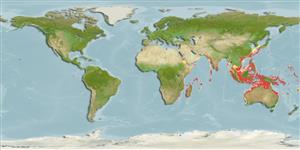>
Eupercaria/misc (Various families in series Eupercaria) >
Labridae (Wrasses)
Etymology: Leptojulis: Greek, leptos = thin + Greek, ioulis, a fish dealing with genera Coris or Thalassoma (Ref. 45335).
More on author: Bleeker.
Environment: milieu / climate zone / rango de profundidad / distribution range
Ecología
marino asociado a arrecife; rango de profundidad 4 - 75 m (Ref. 90102). Tropical
Indo-West Pacific: Gulf of Oman to the Philippines and Australia.
Tamaño / Peso / Age
Madurez: Lm ? range ? - ? cm
Max length : 13.0 cm TL macho / no sexado; (Ref. 2334)
Espinas dorsales (total) : 9; Radios blandos dorsales (total) : 11; Espinas anales: 3; Radios blandos anales: 11 - 12. Slender species, usually with brown or dusky mid-lateral stripe. Male with reflective blue spot in the dark band, just past pectoral fin (Ref. 48636).
Body shape (shape guide): fusiform / normal; Cross section: compressed.
Found in clear coastal slopes to outer reef lagoons on open rubble patches or rocky bottom (Ref. 48636). Occurs in groups (mostly females) on or near reefs, usually where the water is somewhat turbid and rich in plankton. Fish in the initial phase are much more abundant than the terminal males. Feeds on zooplankton at least a meter above the substrate.
Life cycle and mating behavior
Madurez | Reproducción | Puesta | Huevos | Fecundidad | Larva
Oviparous, distinct pairing during breeding (Ref. 205).
Randall, J.E., 1996. Second revision of the labrid fish genus Leptojulis, with descriptions of two new species. Indo-Pac. Fish. (24):20 p. (Ref. 12420)
IUCN Red List Status (Ref. 130435: Version 2025-1)
Threat to humans
Harmless
Human uses
Pesquerías: escaso valor comercial; Acuario: Comercial
Herramientas
Special reports
Download XML
Fuentes de Internet
Estimates based on models
Preferred temperature (Referencia
123201): 24.3 - 29, mean 28 °C (based on 1360 cells).
Phylogenetic diversity index (Referencia
82804): PD
50 = 0.5312 [Uniqueness, from 0.5 = low to 2.0 = high].
Bayesian length-weight: a=0.00977 (0.00470 - 0.02030), b=3.07 (2.90 - 3.24), in cm total length, based on LWR estimates for this (Sub)family-body shape (Ref.
93245).
Nivel trófico (Referencia
69278): 3.4 ±0.45 se; based on food items.
Resiliencia (Referencia
120179): Alto, población duplicada en un tiempo mínimo inferior a 15 meses (Preliminary K or Fecundity.).
Fishing Vulnerability (Ref.
59153): Low vulnerability (10 of 100).
🛈
Nutrients (Ref.
124155): Calcium = 94.5 [55.1, 175.1] mg/100g; Iron = 0.878 [0.502, 1.658] mg/100g; Protein = 18.2 [15.3, 20.4] %; Omega3 = 0.172 [0.102, 0.286] g/100g; Selenium = 27.1 [15.1, 52.2] μg/100g; VitaminA = 222 [67, 805] μg/100g; Zinc = 1.66 [1.11, 2.61] mg/100g (wet weight);
